The Bear 650 is Royal Enfield’s latest 650cc twin but the scrambler’s strongest suit is not what you expect.
When a 16-year-old Eddie Mulder won the annual Big Bear desert race in remarkable circumstances 64 years ago, no one could have predicted that it would one day inspire Royal Enfield’s best-handling motorcycle to date. While the Indian brand didn’t exactly set out to achieve impeccable road manners when it began work on the new 650 retro-styled scrambler, the combination of six years, improved technology and platform evolution has inevitably meant the 2024 Bear 650 is currently the cream of its 650cc parallel-twin crop.
Named after a legendary race in California’s Mojave Desert and based around the company’s Interceptor, the Bear 650 joins the original Continental GT and Interceptor models, the cruiser-style Super Meteor and Shotgun versions and the soon-to-be released Classic 650 as the much-awaited scrambler version of the hugely successful 650 twin platform.
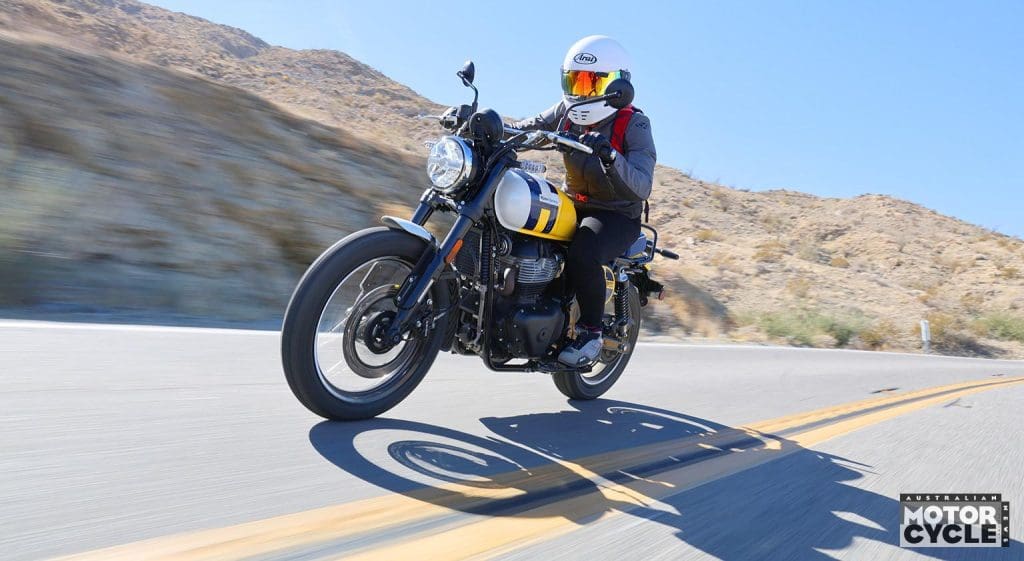
That success is a measure of the capabilities the relatively inexpensive platform has possessed since the Interceptor and Continental GT models were first released back in 2018. Between the steel-tube cradle chassis that was developed in conjunction with the legendary Harris Performance outfit, the really usable 648cc engine and the quality running gear and componentry, the platform has garnered a swag of fans over the last half a dozen years and the new Bear 650 will only widen the appeal and strengthen the success.
It’s powered by the same 648cc eight-valve SOHC parallel-twin as the rest of the line-up, although torque has been increased 8 percent throughout the rev range, thanks in part to the Bear’s new two-into-one exhaust system. Up from 52.3Nm on the current Interceptor, the Bear produces 56.5Nm and peaks 500rpm earlier than before at 5150rpm. While Royal Enfield said there is potential to increase the power output, the engine in its current tune has already reached the power-to-weight ceiling which can cater to LAMS and A2 licence holders, so it remains unchanged at 34.6kW (46.3hp) at 7150rpm.
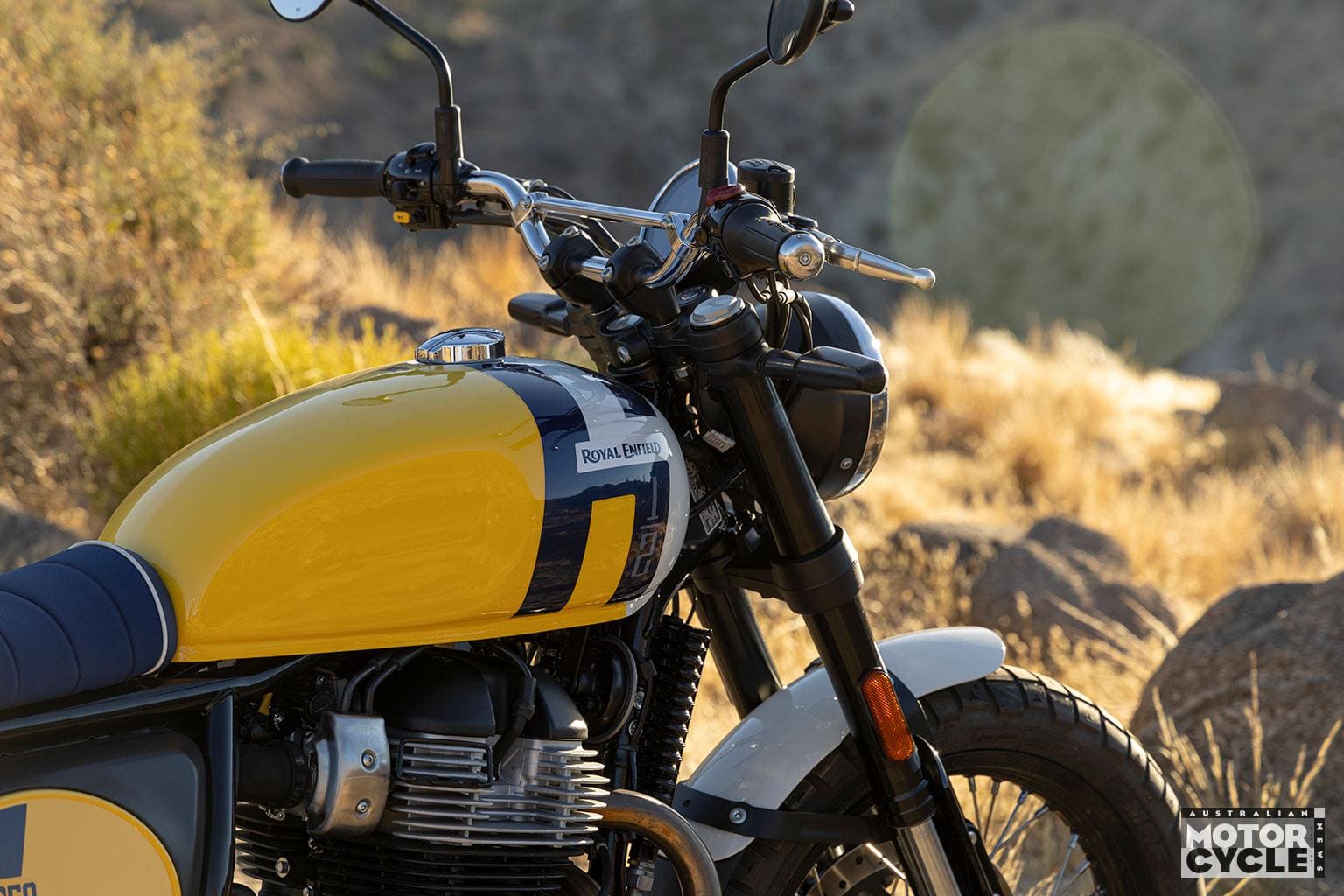
Bear necessities
I can’t say that I could really feel the extra poke the Bear has over the Interceptor. It’s four kilos heavier than the naked bike, which would dampen the responsiveness slightly, but I reckon the gains are matched or even exceeded by the handling improvements made to the Bear, making them more or less unnoticeable.
The six-speed gearbox uses really wide ratios and I couldn’t help but think that slightly shorter gearing could have made a significant difference to the acceleration and really set the bike apart from the others, especially when I only found myself using top gear once or twice during the 250km ride in the California mountains. It’s not slow to build pace but it certainly isn’t fast. While I don’t think ‘fast’ was ever part of the design brief, I think the gearing is slightly too tall for the application.

The highlight for me is easily the feedback offered by the uprated front end. Because even though the Bear rolls on a 19-inch front wheel wrapped in block-pattern rubber compared to the Interceptor’s 18-incher shod with road-oriented tyres, there’s far more confidence to push on the road than I’ve ever received from the earlier roadbikes – and they were easy to ride fast. This is the result of a couple of things. The first is the 43mm upside-down Showa Big Piston front fork, which – despite offering zero adjustment – is set up beautifully. I spoke to one of the techs about just how much time went into finding the base setting and he confirmed that a lot of emphasis was placed on achieving high compliance from a non-adjustable unit, which of course has a positive bearing on the eventual retail price.
Secondly, the headstock has been strengthened to cope with that beefier fork, the larger-diameter front wheel and the increase in the associated forces, a bit like what was done to those original desert sleds that Mulder won on so many times. So while mid-corner bumps on the Interceptor can widen the eyes, there’s no such concern on the Bear, and it’s that stability and feel which make it in my mind the best handling Royal Enfield to date.

Tread lightly
There’s no use having a sweet-handling bike if the tyres aren’t up to the job. Royal Enfield likes to use local tyre suppliers, but because most Indian-made motorcycles are low-capacity commuters, there wasn’t an off-the-shelf product suitable for the dual-sport nature of the Bear. Which is why the development deal with Indian tyre manufacturer MRF came about; Royal Enfield gets the hoops they need for the Bear, MRF gains the know-how, and the whole shebang remains in India.
You and I both know it’s no coincidence that the resulting MRF Nylorex tyres look and feel every bit like a set of Pirelli Scorpion Rally STRs, today’s most popular road-biased off-road tyre. In the 35ºC-plus temperatures I was riding in, they provided plenty of feel and an abundance of grip on the road, and felt really predictable in the short off-road section.

Down the back, the preload-adjustable shocks showed no sign of flaws for my 64kg frame and the front and rear’s 130mm and 115mm of respective travel confirms the Bear’s soft-road intentions, while ground clearance is 184mm, which is 10mm more than the Interceptor. The subframe has received a bit of strengthening too, which Royal Enfield says was done to improve the bike’s luggage-carrying capacity, but the lack of any real wind or weather protection probably limits any meaningful travel to weekends away.
Mind you, the footpegs are mounted lower and farther forward than the Interceptor’s. Combined with the wide handlebar, this make the whole ergonomic experience a bit more open than the Interceptor’s so it’s definitely all-day comfortable. The long flat and narrow seat is reasonably high compared to the rest of the range at 835mm, thanks to the 30mm of extra suspension travel and larger rolling radius of the front hoop, but there’s less seat padding than we’re used to from Royal Enfield to minimise the height increase – however, thankfully, not to the detriment of comfort.
Brembo’s Indian ByBre subsidiary provides the brakes. There’s decent feel from the single-disc front with a 320mm disc gripped by a twin-piston caliper. The rear has a 270mm rear disc and the pedal is easy to find whether sitting or standing.
Simplicity is key
In keeping with Royal Enfield’s century-old legacy of classic simplicity, electronic gadgetry is understated. There’s the obligatory two-channel ABS system which is made by Bosch and it’s switchable, which will please Bear 650 owners who are buying it for its off-tarmac-roads abilities.
The single circular TFT dash from the latest Himalayan and Guerrilla models is carried over onto the Bear 650. Despite its classic appearance, it provides a host of information and display customisation, as well as phone connectivity and turn-by-turn navigation. It’s all operated between a joystick mounted on the left-hand switchblock and a menu button on the right. While it can be a little tricky to the uninitiated, it becomes simple to use with a bit of time. There’s a USB-C charging point on the right-hand side of the dash, too.
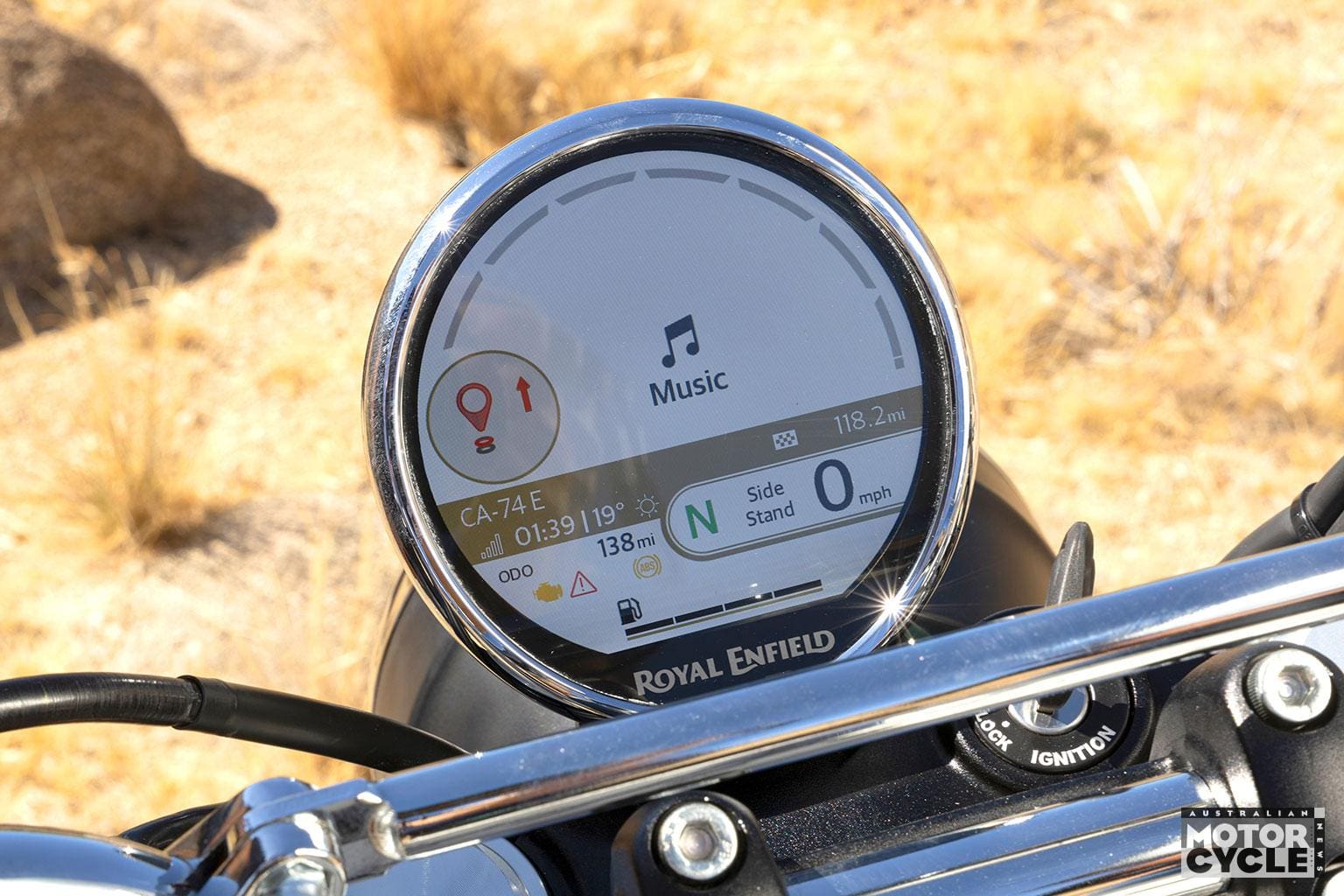
The Bear 650 represents the first time Royal Enfield has used LED lighting all over a bike, and the indicators, daytime running light, and tail and brake lights are all reassuringly bright.
Removing the seat is a two-step process. Using the key, you first remove the plastic side cover/race plate and then tug on a lever, which releases the single seat unit. Under the side plate you’ll find a decent sized tool kit, something Royal Enfield has been quite good at over recent years, but there’s no room under the seat for, well, anything. And you can’t even see the battery, let alone access it. Perhaps that’s an unfair criticism given the practical dual-purpose Bear 650 was merely a glint in its development team’s eye when the packaging for the original Interceptor was decided on back in 2018.
There’s a good-sized grab rail running around the rear of the seat, which doubles as useful tie-down points. A handle is integrated at the top of the left-hand rear shock absorber to aid lifting the bike onto the centrestand, except a centrestand isn’t fitted as standard – only as an optional extra.
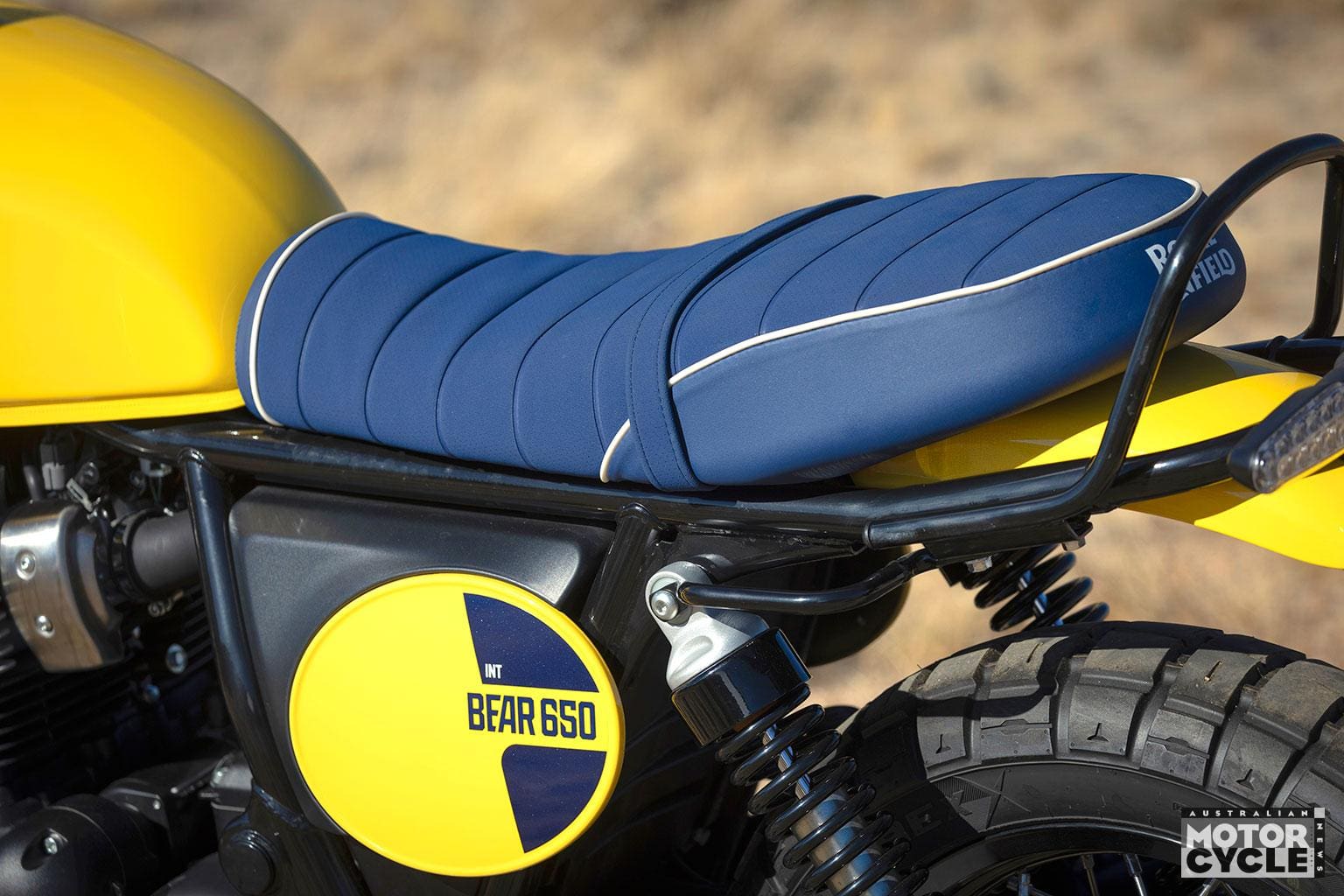
Palette of possibilities
The Bear 650 is available in five colour options, the most striking of which is a nod to Mulder’s race-winning Royal Enfield (see sidebar). Called the Two Four Nine, which was Eddie’s race number, it features the same green frame and the black-and-white checkerboard pattern which adorned Eddie’s jersey (he was a member of the Checkers MC club). Pricing is yet to be announced, but expect to pay a premium price for the Mulder tribute. Depending on the paintwork, the Bear 650 is broken into three price points, starting with the least-expensive Boardwalk White. The mid-tier models will be Petrol Green and Wild Honey, with Golden Shadow and Two Four Nine top of the pricing structure.
The best-looking one to my eye is the yellow-and-blue Wild Honey version, which I made an appropriate beeline for on the morning of the ride. Between the yellow bodywork, blue seat and side race plate, I reckon it’s a dead ringer for Suzuki’s early-70s or late-80s PE enduro series, and the cross brace on the one-piece handlebar tops the whole thing off. Aesthetically I don’t feel like the coke-bottle grips match the tougher scrambler-style look of the Bear 650, but this is one bike from a (so far) six-bike platform and I’m splitting hairs.
What’s not in question is the successful execution of turning a six-year-old naked bike into a 2024-model scrambler. There’s better performance despite tougher emission regulations, the handling is greatly improved despite its soft-road intentions, and I think the scrambler styling is right on the money.
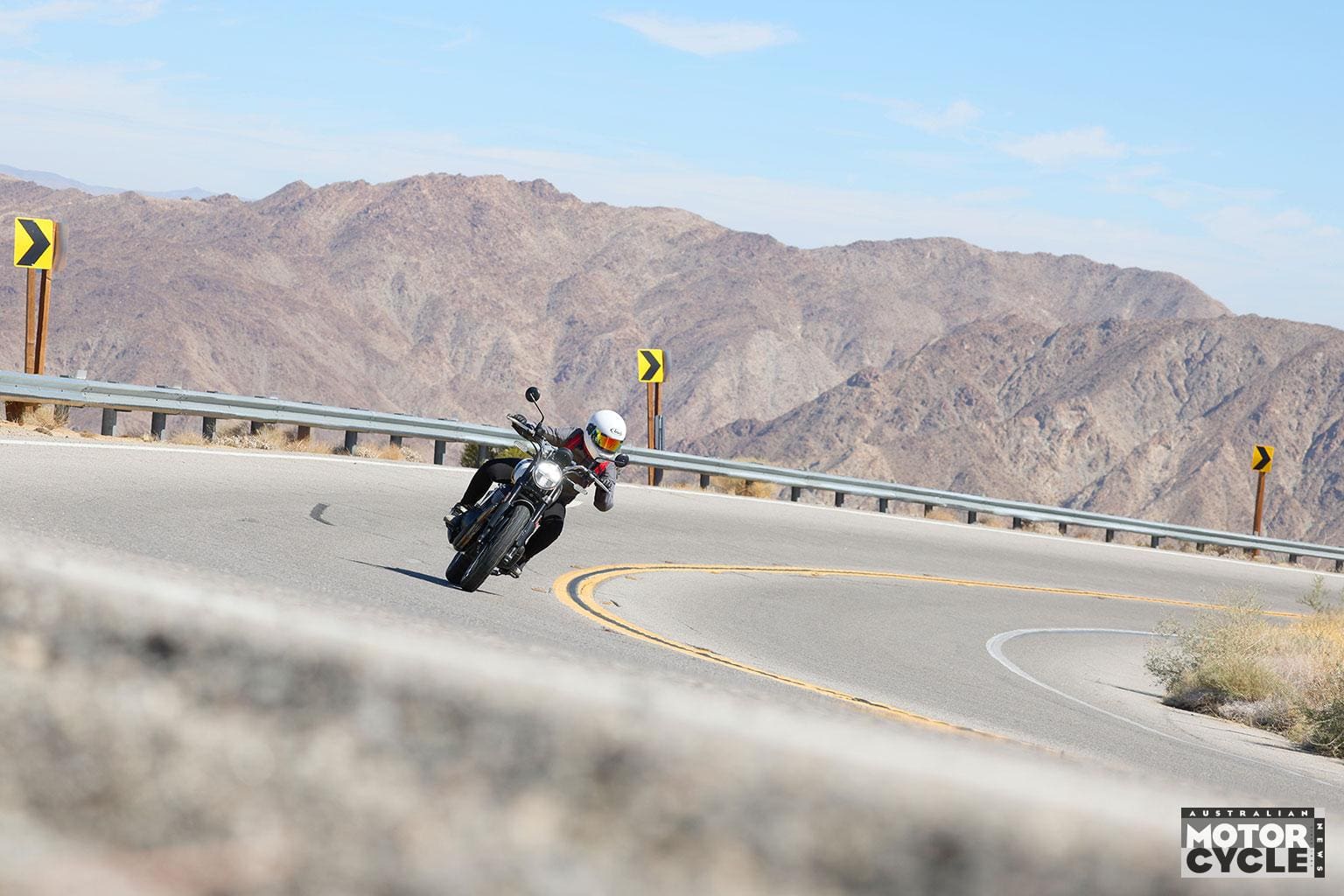
“Your ass is grass”
The race that inspired Royal Enfield’s scrambler
After hooking up with Californian Royal Enfield dealer Mel Denison, youngster Eddie Mulder found himself one of the 765 starters lining up to contest the 1960 Big Bear Run, a clover-leaf style race of three 50-mile (80km) loops.
With his hot, Denison-prepared 500cc single on the start line which, according to Eddie “would pull the cork off any 650 twin”, he realised nature was calling at a very inopportune time.
“I looked at my mum and said ‘I don’t think this needs to wait’… and just as I got cleaned up, the race started. They raised the banner and away everybody went.”
Despite being the last rider to leave the start line, Eddie was already inside the top 20 at the end of the first loop.
“There were 700 riders, but only about 100 of them were racers,” he explained.

He snapped the right footpeg off on a boulder at the beginning of the second loop and raced through the desert with his foot resting on the gearbox.
After a new footpeg and a fresh pair of goggles at the second checkpoint, Eddie began the final loop through Rattlesnake Canyon sitting in 13th place. Tight, technical and littered with switchbacks, his youthful exuberance got the better of him and he overshot a turn, launching his desert sled into the trees.
“I whistled that baby off and left the road,” Eddie remembered. “I put my head down level with the handlebar and all I could hear was snapping branches.”
The severity of the impact was so great that he ripped the header pipe out of the cylinder head and snapped the rear left shock. But thanks to the switchbacks, the 16-year-old somehow emerged back on the track below.
“I kicked the header pipe back in, but I didn’t know the shock was broken,” Eddie said. “But I could smell the dust of the rider in front of me and I thought ‘your ass is grass’. I put my head down and I won the race.”
Just 193 exhausted riders finished that day, 192 of them behind Eddie Mulder. And it was a result that he credits as the launchpad of a career as a champion racer and well-known stuntman in Hollywood.
“It wasn’t Eddie-who anymore, it was Yes-Eddie!” he grinned.
SPECIFICATIONS

Engine
Capacity 648cc
Type Parallel-twin, SOHC,
four valves per cylinder
Bore & stroke 78mm x 67.8mm
Compression ratio 9.5:1
Cooling Air/oil
Fueling EFI, with dual throttle bodies
Transmission Six-speed
Clutch Wet, multi-plate
Final drive Chain
Performance
Power 34.9kW (47.4hp)
@ 7150rpm (claimed)
Torque 56.5Nm @ 5150rpm (claimed)
Top speed 180km/h (est)
Fuel consumption Not measured
Electronics
Type Bosch
Rider aids ABS (switchable)
Rider modes Not applicable
Chassis
Frame material Composite steel
Frame type Double cradle
Rake Not given
Trail Not given
Wheelbase 1460mm
Suspension
Type Showa
Front: 43mm upside-down fork, non-adjustable, 130mm travel
Rear: Dual shocks,
preload adjustable, 115mm travel
Wheels & brakes
Wheels Wire-spoked aluminium
Front: 19 x 2.5 Rear: 17 x 3.5
Tyres MRF Nylorex
Front: 100/90R19 (57H)
Rear: 140/80R17 (69H)
Brakes ByBre, ABS
Front: Single 320mm disc,
twin-piston caliper
Rear: Single 270mm disc,
single-piston caliper
Dimensions
Weight 214kg (kerb, claimed)
Seat height 835mm
Width Not given
Height Not given
Length Not given
Ground clearance 184mm
Fuel capacity 13.7L
Servicing & warranty
Servicing 1000km
Minor: 12,000km
Major: 24,000km
Warranty Three years, unlimited km, roadside assist
Business end
Price TBC
Colour options Boardwalk White,
Petrol Green, Wild Honey, Golden Shadow and Two Four Nine
Contact












